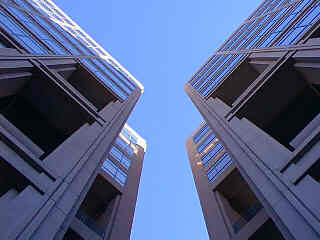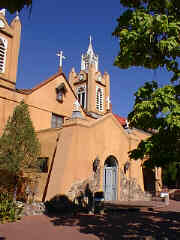
Albuquerque has glorious vistas, a nearly perfect climate, and large tracts of pristine open space offering recreation for people and habitats for wildlife. Its desirability as a place to live is further enhanced by an rich cultural heritage and the stimulation of a diversified, multiethnic population. With such a combination, our growing built city should project a strong, clear, sense of place, a unique identity as a modern New Mexico urban community.
V. B. Price, local commentator on the built environment, says, "In an ideal city, planning for growth and preserving a sense of place would be complementary pursuits, the former attracting and nurturing vitality, the latter strengthening and clarifying integrity. In the built environment, as with cultures and personalities, vitality and integrity are the foundations of well-being."
The ideal is seldom achieved, however. Albuquerque is a typical post-World War II American city. It grew up in response to federal programs offering low-interest mortgages to suburban home buyers and highway building that facilitated personal mobility with cars.
Albuquerque has some interesting individual buildings and sites, some special residential neighborhoods, the University of New Mexico campus, and a redeveloping downtown. However, a cross-town drive only reveals a low-density sprawl of residential neighborhoods separated by overly wide, featureless streets lined with miles of repetitious shopping centers, fast-food franchise architecture, and individual commercial buildings surrounded by parking lots.
Albuquerque grew rapidly in the 1960s and 1970s. The city responded to its unplanned and ungainly growth with the 1975 Albuquerque/Bernalillo County Comprehensive Plan. City and county government professionals, elected officials, special-interest groups, and citizens participated in the plan's creation and publication.
The 1975 plan raised and addressed area-wide concerns about resources, the environment, development, and planning. The plan included both policies and official maps, which designated open space areas, metropolitan boundaries with prescribed density ranges, and urban centers.
 The
plan's objectives were to:
The
plan's objectives were to:
Following the adoption of Albuquerque/Bernalillo County Comprehensive Plan, area plans and sector development plans were adopted, ordinances were enacted, boards and commissions created, and funding sources established to upgrade our city's image. Sector plans for older areas, developers' sector plans for new development, the Landmarks and Urban Conservation Commission, the City of Albuquerque Beautification Committee, the Sign Ordinance, the Street Tree Ordinance, the Urban Enhancement Trust Fund, and the 1% for Art program have all contributed to improving the built environment. These beautification strategies are discussed in greater detail in Section V, "Albuquerque Environmental Topics."
Land-use policies and practices continue to be updated, and public involvement for establishing a current city vision continues to be sought as the city grows.
In 1982, the mayor and city council established a goals committee to advocate for and monitor Comprehensive Plan implementation. Their 1983-84 Goals Committee Report led to the Comprehensive Plan revision and the formation of a goals commission.
A revised Comprehensive Plan establishing goals, policies, and monitoring and implementation techniques for land use, environmental protection, heritage conservation, and community resource management was adopted in 1988.
Since the 1988 plan was adopted, its implementation is reviewed every few years by all city departments and the goals commission. Shared Vision, Inc., a broad-based, nonprofit organization, was developed in the 1990s to continually encourage Albuquerqueans to share their ideas, goals and dreams for protecting, preserving and enhancing our quality of life in the city.
Some examples of adopted plans and programs that are shaping the city are the 1986 Facility Plan for Arroyos and subsequent arroyo corridor plans, the 1993 Trails and Bikeways Facility Plan, and the 1995 Community-Based Planning Program. The upcoming plans for acequias, parks and open space facilities, the west side area, and the transportation evaluation study will also help sustain and improve our city.
The mission of Shared Vision, Inc. is to stimulate community awareness, dialogue, and action in developing consensus and realizing the vision of a vital and sustainable community. The organization goal is to build a dynamic and diverse community celebrating its heritage, committed to sharing power and opportunity, and working in harmony to sustain our environment and create economic vitality for this and future generations.
Our work toward these goals is helping to shape Albuquerque into a more sustainable and beautiful city. Continued dialogue among residents, business owners, and institutions keep the city vision dynamic and vital.
(Up to Section II, Back to Suggested Trips for Exploring Albuquerque's Natural Environment, On to Architecture and Infrastructure)